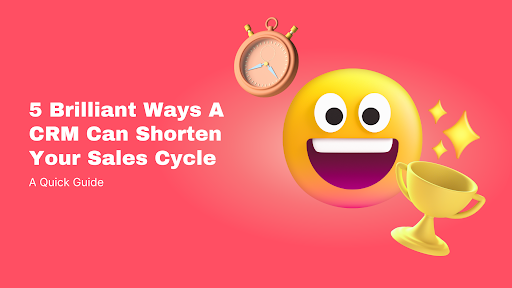If you’re a salesperson or a marketer, I’m sure you’d nod along when I say - Our days are like strands of spaghetti with tasks tangled on one another.
With a prospect at the BOFU to attend to, a prospect to cold call, an email blast to blog subscribers, and whatnot?
In the middle of this chaos, we’d also have to build solid relationships with the customers and stay in the know about what’s happening end-to-end (I’m not even kidding!).
But, as people in the creative space, just drive and passion won’t make the cut.
We need tools and resources to help us escape spreadsheets, manual emails, back and forth follow-ups.
The obvious answer?
Yes, Automation.
Automation helps us streamline workflows and make our lives easier and more productive.
The two pillars of automation tools that make sales and marketing folks sail through their daily tasks are email automation and CRM software.
Today, we’d be seeing how a CRM can help sales and marketing shorten their sales cycle and drive more revenue.
Let’s begin.
Some important Ways A CRM Can Shorten Your Sales Cycle
- Break the silos and make the team more productive
The marketing and sales teams have to collaborate on a daily basis on multiple tasks. In fact, there’s a continuous loop between the functions of the two departments.
Marketing qualifies a lead and hands it over to the sales team for closure.
Now, in the absence of a CRM, marketing and sales would have no visibility into the stage of the funnel and the customer’s journey.
With CRM, the sales and marketing team can stay on the same page by:
- Quicker lead qualification and conversion
- Tracking the leads and understanding the stage in the funnel
- Taking action without wasting time and while keeping everyone informed
- Contextual communication and elimination of over lapses
With CRM, you can make sure that you nurture your prospects and nudge them periodically.
2. Automate the head to tail of the sales process and save more time
You can automate emails and prompt them to take action no matter what stage of the buyer’s journey they are in. This is particularly helpful for eCommerce marketers who automate a lot of their emails including order confirmation, welcome emails, abandoned cart emails, and more.
You can automate your communication based on regular time intervals and make sure that you send the right message at the right time.
This ensures that your prospect has all the information to make the right decision thereby considerably reducing the duration of the sales cycle.
This gives sales and marketing teams time to spare which can be directed towards actual selling rather than mending with repetitive tasks.
3. Crunch the data and optimize your sales cycle
Any CRM software would have a dashboard for reports and analytics that helps sales teams understand the key metrics.
CRM helps in gauging solid insights into email performance metrics, notes of cold calling, and the overall campaign performance.
This helps in shortening the sales cycle because there would be a clear understanding of:
- Potential prospects and cold ones
- Forecast sales performance
- Align the team to achieve the projected goals
- Understand the performance thus far and draw insights
This gives the overall picture of how your sales pipeline looks and makes solid plans for an upward trajectory.
4. Escape spreadsheets and get a single unified view of all the information
A gazillion spreadsheets for your data can be dreadful! Imagine having to pull out a different sheet every time to know when the lead signed up, where they navigated, what asset they downloaded, or perhaps what stage of the funnel they were in at the moment!
With CRM, you can get a complete overview of all the information that you’d ever need right from the moment they sign up!
All the information about the prospect, their interests, and the conversations you’ve had with them so far can make your future conversations contextual, less redundant, and more compelling.
- Helps marketing teams understand the conversations with the customers and trigger contextual emails (say offers or a helpful ebook depending upon the stage in the funnel)
- This also helps sales teams understand the prospect before getting into a conversation with them. They can get some context about how the prospect found the company, what did they do before signing up, and which marketing asset were they interested in (if this was an inbound lead)
5. Close more deals with sales pipeline and funnel tracking
A typical sales pipeline looks like this:
- Qualifying the leads
- Understanding prospects’ needs
- Nurturing the lead
- MQL and SQL
- Won deal or lost deal
- Post-sale in case of won lead
In the absence of a CRM, it’d become difficult to manually go through these stages with no instant data on how each stage has ended.
CRM lets you progress through the sales pipeline at ease and with more context thereby avoiding the possibility of missing information and data silos.
This not only helps in shortening the sales cycle but also significantly improving conversions.
Peddling The Cycle To The Finish - Conclusion
Just like a successful sales cycle that ends in a solid conversion, this article has also come to the finishing point!
For any organization, sales and marketing are critical revenue-generating departments.
A lot of their tasks are interlinked and interdependent. Thus, it is not recommended for them to act in silos.
Also, the sales teams have a lot of information to process for each and every prospect. Multiple spreadsheets and manual processes can make their jobs monotonous and boring.
CRMs can help in automating routine tasks and significantly reduce the sales cycle - thereby letting sales folks focus on their core job (SELLING!).
Author Bio
Nandhini is a Product Marketer at TargetBay - An all in one eCommerce marketing solution used by thousands of online businesses across the globe. She loves to talk about the power of emails in marketing and when not doing that, she's busy using her bulky planners and sticky notes or binging TV shows!



